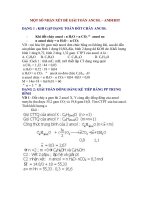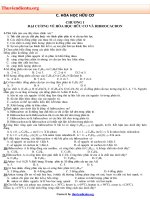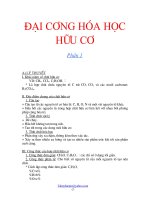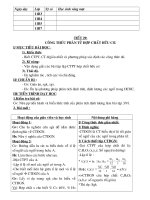- Trang chủ >>
- Sư phạm >>
- Sư phạm hóa
ORGANIC CHEMISTRY (hóa học hữu cơ _FOURTH EDITION_Maitland Jones, Jr. Steven A. Fleming
Bạn đang xem bản rút gọn của tài liệu. Xem và tải ngay bản đầy đủ của tài liệu tại đây (14.36 MB, 1,311 trang )
FOURTH EDITION
ORGANIC CHEMISTRY
Maitland Jones, Jr.
Steven A. Fleming
Organic Chemistry
Organic Chemistry
FOURTH EDITION
Maitland Jones, Jr.
NEW YORK UNIVERSITY
Steven A. Fleming
TEMPLE UNIVERSITY
W. W. Norton & Company
New York • London
Drawing structures and reactions is critical to understanding them. The front and back covers show chair
cyclohexanes, which are introduced in Chapter 5 and appear over and over again in the natural world.
These structures were hand-drawn and have ever-so-small imperfections. Evaluate these chairs, and after
you finish Chapter 5, we suggest you take a very close look to see how you might improve them.
W.W. Norton & Company has been independent since its founding in 1923, when William Warder Norton
and Mary D. Herter Norton first published lectures delivered at the People’s Institute, the adult education
division of New York City’s Cooper Union.The Nortons soon expanded their program beyond the Institute,
publishing books by celebrated academics from America and abroad. By mid-century, the two major pillars
of Norton’s publishing program—trade books and college texts—were firmly established. In the 1950s, the
Norton family transferred control of the company to its employees, and today—with a staff of four hundred
and a comparable number of trade, college, and professional titles published each year—W.W. Norton &
Company stands as the largest and oldest publishing house owned wholly by its employees.
Copyright © 2010, 2005, 2000, 1997 by W.W. Norton & Company, Inc.
All rights reserved
Printed in the United States of America
Editor: Erik Fahlgren
Project editor: Carla L. Talmadge
Marketing manager: Kelsey Volker
Editorial assistant: Mary Lynch
Production manager: Chris Granville
Managing editor, College: Marian Johnson
Ancillaries editor: Matthew A. Freeman
Media editor: Rob Bellinger
Developmental editor: Irene Nunes
Design director: Rubina Yeh
Photo editor: Junenoire Mitchell
Cover design: John Hamilton
Composition: Prepare, Inc.
Illustration studio: Penumbra Design, Inc.
Manufacturing: Transcontinental Interglobe
Library of Congress Cataloging-in-Publication Data
Jones, Maitland, 1937–
Organic chemistry / Maitland Jones, Jr.—4th ed. / Steven A. Fleming.
p. cm.
Includes bibliographical references and index.
ISBN 978-0-393-93149-5 (hardcover)
1. Chemistry, Organic—Textbooks. I. Fleming, Steven A. II.Title.
QD253.2.J66 2010
547—dc22 2009033807
W.W. Norton & Company, Inc., 500 Fifth Avenue, New York, N.Y. 10110
www.wwnorton.com
W.W. Norton & Company Ltd., Castle House, 75/76 Wells Street, London W1T 3QT
1234567890
1 Atoms and Molecules; Orbitals and Bonding 1
2 Alkanes 50
3 Alkenes and Alkynes 97
4 Stereochemistry 147
5 Rings 185
6 Alkyl Halides, Alcohols, Amines, Ethers,
and Their Sulfur-Containing Relatives 223
7 Substitution and Elimination Reactions:
The S
N
2, S
N
1, E1, and E2 Reactions 261
8 Equilibria 331
9 Additions to Alkenes 1 363
10 Additions to Alkenes 2 and Additions to Alkynes 409
11 Radical Reactions 467
12 Dienes and the Allyl System: 2p Orbitals in Conjugation 511
13 Conjugation and Aromaticity 571
14 Substitution Reactions of Aromatic Compounds 623
15 Analytical Chemistry: Spectroscopy 694
16 Carbonyl Chemistry 1: Addition Reactions 762
17 Carboxylic Acids 828
18 Derivatives of Carboxylic Acids: Acyl Compounds 876
19 Carbonyl Chemistry 2: Reactions at the α Position 931
20 Special Topic: Reactions Controlled by Orbital Symmetry 1030
21 Special Topic: Intramolecular Reactions
and Neighboring Group Participation 1080
22 Special Topic: Carbohydrates 1124
23 Special Topic: Amino Acids and Polyamino Acids
(Peptides and Proteins) 1173
Brief Contents
v
Selected Applications xix
Organic Reaction Animations xxi
Preface to the Fourth Edition xxiii
Introduction xxxiii
1 Atoms and Molecules; Orbitals and Bonding 1
1.1 Preview 2
1.2 Atoms and Atomic Orbitals 4
1.3 Covalent Bonds and Lewis Structures 13
1.4 Resonance Forms 22
1.5 Hydrogen (H
2
): Molecular Orbitals 30
1.6 Bond Strength 36
1.7 An Introduction to Reactivity: Acids and Bases 41
1.8 Special Topic: Quantum Mechanics and Babies 42
1.9 Summary 43
1.10 Additional Problems 45
2 Alkanes 50
2.1 Preview 51
2.2 Hybrid Orbitals: Making a Model for Methane 52
2.3 The Methyl Group (CH
3
) and Methyl Compounds (CH
3
X) 60
2.4 The Methyl Cation (
+
CH
3
), Anion (
−
:
CH
3
), and Radical (·CH
3
)62
2.5 Ethane (C
2
H
6
), Ethyl Compounds (C
2
H
5
X),
and Newman Projections 64
2.6 Structure Drawings 70
2.7 Propane (C
3
H
8
) and Propyl Compounds (C
3
H
7
X) 71
2.8 Butanes (C
4
H
10
), Butyl Compounds (C
4
H
9
X),
and Conformational Analysis 73
2.9 Pentanes (C
5
H
12
) and Pentyl Compounds (C
5
H
11
X) 76
2.10 The Naming Conventions for Alkanes 78
vii
Contents
2.11 Drawing Isomers 82
2.12 Rings 83
2.13 Physical Properties of Alkanes and Cycloalkanes 86
2.14 Nuclear Magnetic Resonance Spectroscopy 88
2.15 Acids and Bases Revisited: More Chemical Reactions 90
2.16 Special Topic: Alkanes as Biomolecules 92
2.17 Summary 93
2.18 Additional Problems 94
3 Alkenes and Alkynes 97
3.1 Preview 98
3.2 Alkenes: Structure and Bonding 99
3.3 Derivatives and Isomers of Alkenes 107
3.4 Nomenclature 110
3.5 The Cahn–Ingold–Prelog Priority System 112
3.6 Relative Stability of Alkenes: Heats of Formation 115
3.7 Double Bonds in Rings 118
3.8 Physical Properties of Alkenes 123
3.9 Alkynes: Structure and Bonding 123
3.10 Relative Stability of Alkynes: Heats of Formation 126
3.11 Derivatives and Isomers of Alkynes 126
3.12 Triple Bonds in Rings 128
3.13 Physical Properties of Alkynes 129
3.14 Acidity of Alkynes 129
3.15 Molecular Formulas and Degrees of Unsaturation 130
3.16 An Introduction to Addition Reactions of Alkenes and Alkynes 131
3.17 Mechanism of the Addition of Hydrogen Halides to Alkenes 132
3.18 The Regiochemistry of the Addition Reaction 137
3.19 A Catalyzed Addition to Alkenes: Hydration 139
3.20 Synthesis: A Beginning 141
3.21 Special Topic: Alkenes and Biology 142
3.22 Summary 143
3.23 Additional Problems 144
viii CONTENTS
4 Stereochemistry 147
4.1 Preview 148
4.2 Chirality 149
4.3 The (R/S) Convention 152
4.4 Properties of Enantiomers: Physical Differences 155
4.5 The Physical Basis of Optical Activity 157
4.6 Properties of Enantiomers: Chemical Differences 159
4.7 Interconversion of Enantiomers by Rotation about a Single Bond:
gauche-Butane 163
4.8 Diastereomers and Molecules Containing More than One Stereogenic
Atom 164
4.9 Physical Properties of Diastereomers: Resolution, a Method of Separating
Enantiomers from Each Other 169
4.10 Determination of Absolute Configuration (R or S) 172
4.11 Stereochemical Analysis of Ring Compounds (a Beginning) 173
4.12 Summary of Isomerism 176
4.13 Special Topic: Chirality without “Four Different Groups Attached to One
Carbon” 177
4.14 Special Topic: Stereochemistry in the Real World: Thalidomide, the
Consequences of Being Wrong-Handed 180
4.15 Summary 181
4.16 Additional Problems 182
5 Rings 185
5.1 Preview 186
5.2 Rings and Strain 187
5.3 Quantitative Evaluation of Strain Energy 193
5.4 Stereochemistry of Cyclohexane: Conformational Analysis 197
5.5 Monosubstituted Cyclohexanes 199
5.6 Disubstituted Ring Compounds 204
5.7 Bicyclic Compounds 211
5.8 Special Topic: Polycyclic Systems 216
5.9 Special Topic: Adamantanes in Materials and Biology 217
5.10 Summary 219
5.11 Additional Problems 220
CONTENTS ix
6 Alkyl Halides, Alcohols, Amines, Ethers,
and Their Sulfur-Containing Relatives 223
6.1 Preview 224
6.2 Alkyl Halides: Nomenclature and Structure 225
6.3 Alkyl Halides as Sources of Organometallic Reagents:
A Synthesis of Hydrocarbons 227
6.4 Alcohols 230
6.5 Solvents in Organic Chemistry 238
6.6 Diols (Glycols) 240
6.7 Amines 240
6.8 Ethers 249
6.9 Special Topic: Thiols (Mercaptans) and Thioethers (Sulfides) 251
6.10 Special Topic: Crown Ethers 254
6.11 Special Topic: Complex Nitrogen-Containing
Biomolecules—Alkaloids 255
6.12 Summary 256
6.13 Additional Problems 258
7 Substitution and Elimination Reactions:
The S
N
2, S
N
1, E1, and E2 Reactions 261
7.1 Preview 262
7.2 Review of Lewis Acids and Bases 263
7.3 Reactions of Alkyl Halides: The Substitution Reaction 267
7.4 Substitution, Nucleophilic, Bimolecular: The S
N
2 Reaction 268
7.5 The S
N
2 Reaction in Biochemistry 288
7.6 Substitution, Nucleophilic, Unimolecular: The S
N
1 Reaction 289
7.7 Summary and Overview of the S
N
2 and S
N
1 Reactions 296
7.8 The Unimolecular Elimination Reaction: E1 298
7.9 The Bimolecular Elimination Reaction: E2 301
7.10 What Can We Do with These Reactions?
How to Do Organic Synthesis 312
7.11 Summary 320
7.12 Additional Problems 323
8 Equilibria 331
8.1 Preview 332
8.2 Equilibrium 334
x CONTENTS
8.3 Entropy in Organic Reactions 337
8.4 Rates of Chemical Reactions 339
8.5 Rate Constant 341
8.6 Energy Barriers in Chemical Reactions:
The Transition State and Activation Energy 342
8.7 Reaction Mechanism 349
8.8 The Hammond Postulate: Thermodynamics versus Kinetics 351
8.9 Special Topic: Enzymes and Reaction Rates 357
8.10 Summary 358
8.11 Additional Problems 360
9 Additions to Alkenes 1 363
9.1 Preview 364
9.2 Mechanism of the Addition of Hydrogen Halides to Alkenes 365
9.3 Effects of Resonance on Regiochemistry 366
9.4 Brief Review of Resonance 372
9.5 Resonance and the Stability of Carbocations 374
9.6 Inductive Effects on Addition Reactions 378
9.7 HX Addition Reactions: Hydration 380
9.8 Dimerization and Polymerization of Alkenes 384
9.9 Rearrangements during HX Addition to Alkenes 386
9.10 Hydroboration 390
9.11 Hydroboration in Synthesis: Alcohol Formation 398
9.12 Special Topic: Rearrangements in Biological Processes 401
9.13 Summary 402
9.14 Additional Problems 404
10 Additions to Alkenes 2 and Additions to Alkynes 409
10.1 Preview 410
10.2 Addition of H
2
and X
2
Reagents 410
10.3 Hydration through Mercury Compounds: Oxymercuration 421
10.4 Other Addition Reactions Involving Three-Membered Rings: Oxiranes
and Cyclopropanes 423
10.5 Dipolar Addition Reactions: Ozonolysis and the Synthesis
of Carbonyl (R
2
C O) Compounds 436
10.6 Addition Reactions of Alkynes: HX Addition 444
10.7 Addition of X
2
Reagents to Alkynes 447
P
CONTENTS xi
10.8 Hydration of Alkynes 448
10.9 Hydroboration of Alkynes 450
10.10 Hydrogenation of Alkynes: Alkene Synthesis
through syn Hydrogenation 452
10.11 Reduction by Sodium in Ammonia: Alkene Synthesis
through anti Hydrogenation 452
10.12 Special Topic: Three-Membered Rings in Biochemistry 455
10.13 Summary 456
10.14 Additional Problems 460
11 Radical Reactions 467
11.1 Preview 468
11.2 Formation and Simple Reactions of Radicals 469
11.3 Structure and Stability of Radicals 477
11.4 Radical Addition to Alkenes 481
11.5 Other Radical Addition Reactions 487
11.6 Radical-Initiated Addition of HBr to Alkynes 489
11.7 Photohalogenation 490
11.8 Allylic Halogenation: Synthetically Useful Reactions 497
11.9 Special Topic: Rearrangements (and Nonrearrangements)
of Radicals 501
11.10 Special Topic: Radicals in Our Bodies; Do Free Radicals Age Us? 504
11.11 Summary 505
11.12 Additional Problems 507
12 Dienes and the Allyl System: 2p Orbitals in Conjugation 511
12.1 Preview 512
12.2 Allenes 513
12.3 Related Systems: Ketenes and Cumulenes 515
12.4 Allenes as Intermediates in the Isomerization of Alkynes 516
12.5 Conjugated Dienes 519
12.6 The Physical Consequences of Conjugation 521
12.7 Molecular Orbitals and Ultraviolet Spectroscopy 525
12.8 Polyenes and Vision 533
12.9 The Chemical Consequences of Conjugation:
Addition Reactions of Conjugated Dienes 534
12.10 Thermodynamic and Kinetic Control of Addition Reactions 537
xii CONTENTS
12.11 The Allyl System: Three Overlapping 2p Orbitals 541
12.12 The Diels–Alder Reaction of Conjugated Dienes 544
12.13 Special Topic: Biosynthesis of Terpenes 554
12.14 Special Topic: Steroid Biosynthesis 559
12.15 Summary 563
12.16 Additional Problems 564
13 Conjugation and Aromaticity 571
13.1 Preview 572
13.2 The Structure of Benzene 573
13.3 A Resonance Picture of Benzene 575
13.4 The Molecular Orbital Picture of Benzene 578
13.5 Quantitative Evaluations of Resonance Stabilization in Benzene 580
13.6 A Generalization of Aromaticity: Hückel’s 4n + 2 Rule 582
13.7 Substituted Benzenes 595
13.8 Physical Properties of Substituted Benzenes 598
13.9 Heterobenzenes and Other Heterocyclic Aromatic Compounds 598
13.10 Polynuclear Aromatic Compounds 602
13.11 Introduction to the Chemistry of Benzene 606
13.12 The Benzyl Group and Its Reactivity 610
13.13 Special Topic: The Bio-Downside, the Mechanism of Carcinogenesis
by Polycyclic Aromatic Compounds 614
13.14 Summary 617
13.15 Additional Problems 619
14 Substitution Reactions of Aromatic Compounds 623
14.1 Preview 624
14.2 Hydrogenation of Aromatic Compounds 626
14.3 Diels–Alder Reactions 628
14.4 Substitution Reactions of Aromatic Compounds 631
14.5 Carbon–Carbon Bond Formation: Friedel–Crafts Alkylation 639
14.6 Friedel–Crafts Acylation 643
14.7 Synthetic Reactions We Can Do So Far 646
14.8 Electrophilic Aromatic Substitution of Heteroaromatic Compounds 652
14.9 Disubstituted Benzenes: Ortho, Meta, and Para Substitution 655
14.10 Inductive Effects in Aromatic Substitution 666
CONTENTS xiii
14.11 Synthesis of Polysubstituted Benzenes 668
14.12 Nucleophilic Aromatic Substitution 674
14.13 Special Topic: Stable Carbocations in “Superacid” 679
14.14 Special Topic: Benzyne 680
14.15 Special Topic: Biological Synthesis of Aromatic Rings;
Phenylalanine 682
14.16 Summary 685
14.17 Additional Problems 688
15 Analytical Chemistry: Spectroscopy 694
15.1 Preview 695
15.2 Chromatography 697
15.3 Mass Spectrometry (MS) 699
15.4 Infrared Spectroscopy (IR) 707
15.5
1
H Nuclear Magnetic Resonance Spectroscopy (NMR) 713
15.6 NMR Measurements 717
15.7
13
C NMR Spectroscopy 740
15.8 Problem Solving: How to Use Spectroscopy to Determine Structure 742
15.9 Special Topic: Dynamic NMR 746
15.10 Summary 750
15.11 Additional Problems 751
16 Carbonyl Chemistry 1: Addition Reactions 762
16.1 Preview 763
16.2 Structure of the Carbon–Oxygen Double Bond 764
16.3 Nomenclature of Carbonyl Compounds 767
16.4 Physical Properties of Carbonyl Compounds 770
16.5 Spectroscopy of Carbonyl Compounds 770
16.6 Reactions of Carbonyl Compounds: Simple Reversible Additions 773
16.7 Equilibrium in Addition Reactions 777
16.8 Other Addition Reactions: Additions of Cyanide and Bisulfite 781
16.9 Addition Reactions Followed by Water Loss: Acetal Formation 783
16.10 Protecting Groups in Synthesis 788
16.11 Addition Reactions of Nitrogen Bases:
Imine and Enamine Formation 790
16.12 Organometallic Reagents 797
xiv CONTENTS
16.13 Irreversible Addition Reactions: A General Synthesis of Alcohols 799
16.14 Oxidation of Alcohols to Carbonyl Compounds 802
16.15 Retrosynthetic Alcohol Synthesis 807
16.16 Oxidation of Thiols and Other Sulfur Compounds 809
16.17 The Wittig Reaction 811
16.18 Special Topic: Biological Oxidation 813
16.19 Summary 816
16.20 Additional Problems 821
17 Carboxylic Acids 828
17.1 Preview 829
17.2 Nomenclature and Properties of Carboxylic Acids 830
17.3 Structure of Carboxylic Acids 832
17.4 Infrared and Nuclear Magnetic Resonance
Spectra of Carboxylic Acids 833
17.5 Acidity and Basicity of Carboxylic Acids 834
17.6 Synthesis of Carboxylic Acids 839
17.7 Reactions of Carboxylic Acids 841
17.8 Special Topic: Fatty Acids 862
17.9 Summary 867
17.10 Additional Problems 870
18 Derivatives of Carboxylic Acids: Acyl Compounds 876
18.1 Preview 877
18.2 Nomenclature 879
18.3 Physical Properties and Structures of Acyl Compounds 884
18.4 Acidity and Basicity of Acyl Compounds 885
18.5 Spectral Characteristics 887
18.6 Reactions of Acid Chlorides: Synthesis of Acyl Compounds 889
18.7 Reactions of Anhydrides 894
18.8 Reactions of Esters 895
18.9 Reactions of Amides 901
18.10 Reactions of Nitriles 904
18.11 Reactions of Ketenes 907
18.12 Special Topic: Other Synthetic Routes to Acid Derivatives 907
18.13 Special Topic: Thermal Elimination Reactions of Esters 912
CONTENTS xv
18.14 Special Topic: A Family of Concerted Rearrangements
of Acyl Compounds 914
18.15 Summary 921
18.16 Additional Problems 925
19 Carbonyl Chemistry 2: Reactions at the ␣ Position 931
19.1 Preview 932
19.2 Many Carbonyl Compounds Are Weak Brønsted Acids 933
19.3 Racemization of Enols and Enolates 944
19.4 Halogenation in the α Position 946
19.5 Alkylation in the α Position 954
19.6 Addition of Carbonyl Compounds to the α Position:
The Aldol Condensation 965
19.7 Reactions Related to the Aldol Condensation 980
19.8 Addition of Acid Derivatives to the α Position:
The Claisen Condensation 985
19.9 Variations on the Claisen Condensation 992
19.10 Special Topic: Forward and Reverse Claisen
Condensations in Biology 996
19.11 Condensation Reactions in Combination 998
19.12 Special Topic: Alkylation of Dithianes 1001
19.13 Special Topic: Amines in Condensation Reactions,
the Mannich Reaction 1003
19.14 Special Topic: Carbonyl Compounds without α Hydrogens 1004
19.15 Special Topic: The Aldol Condensation in the Real World, an
Introduction to Modern Synthesis 1007
19.16 Summary 1010
19.17 Additional Problems 1017
20 Special Topic: Reactions Controlled by Orbital Symmetry 1030
20.1 Preview 1031
20.2 Concerted Reactions 1032
20.3 Electrocyclic Reactions 1034
20.4 Cycloaddition Reactions 1043
20.5 Sigmatropic Shift Reactions 1048
20.6 The Cope Rearrangement 1059
20.7 A Molecule with a Fluxional Structure 1063
20.8 How to Work Orbital Symmetry Problems 1071
xvi CONTENTS
20.9 Summary 1073
20.10 Additional Problems 1074
21 Special Topic: Intramolecular Reactions
and Neighboring Group Participation 1080
21.1 Preview 1081
21.2 Heteroatoms as Neighboring Groups 1083
21.3 Neighboring π Systems 1096
21.4 Single Bonds as Neighboring Groups 1108
21.5 Coates’ Cation 1117
21.6 Summary 1118
21.7 Additional Problems 1118
22 Special Topic: Carbohydrates 1124
22.1 Preview 1125
22.2 Nomenclature and Structure of Carbohydrates 1126
22.3 Formation of Carbohydrates 1138
22.4 Reactions of Carbohydrates 1140
22.5 The Fischer Determination of the Structure of
D-Glucose
(and the 15 Other Aldohexoses) 1153
22.6 Special Topic: An Introduction to Di- and Polysaccharides 1161
22.7 Summary 1168
22.8 Additional Problems 1170
23 Special Topic: Amino Acids and Polyamino
Acids (Peptides and Proteins) 1173
23.1 Preview 1174
23.2 Amino Acids 1175
23.3 Reactions of Amino Acids 1186
23.4 Peptide Chemistry 1189
23.5 Nucleosides, Nucleotides, and Nucleic Acids 1210
23.6 Summary 1215
23.7 Additional Problems 1218
Glossary G-1
Credits C-1
Index I-1
CONTENTS xvii
xix
Helium 5
Methane 60
Ethylene: A Plant Hormone 106
Strychnine 172
Thalidomide 180
Carboranes: Weird Bonding 217
Synthetic diamonds 219
Ajoene 252
Malic Acid 274
Cholesterol Formation 358
Ethyl Alcohol 400
Pyrethrins 456
Radical inhibitors as food preservatives 484
Vitamin E 505
Vitamin A and vision 533
Bombykol 534
The birth-control pill 562
Vanillin 582
Carcinogens 605
Carcinogenesis 614
Aniline 648
Magnetic resonance imaging (MRI) 713
Maitotoxin 745
Civetone 769
Salicylic Acid 838
Nylon and polyesters 852
Fats, oils, soaps, and detergents 862
Velcro 898
Eat Your Broccoli! 921
Anticancer drugs 980
Palytoxin 1009
Chorismate to Prephenate:
A Biological Cope Rearrangement 1063
Mustard Gas 1089
Sugar Substitutes 1164
Cellulose and starch 1168
Canavanine: An Unusual Amino Acid 1177
DNA and RNA 1211
Selected Applications
xxi
Organic Reaction Animations
Bimolecular nucleophilic substitution: S
N
2 267
Halide formation 285
Unimolecular nucleophilic substitution: S
N
1 289
Unimolecular elimination: E1 298
Bimolecular elimination: E2 301
Hofmann elimination 308
Acetylide addition 312
Intramolecular S
N
2 316
S
N
2 with cyanide 344
Alkene hydrohalogenation 365
Alkene hydration 381
Alkene polymerization 385
Carbocation rearrangement E1 389
Alkene hydroboration 390
Alkene halogenation 414
Stabilized alkene halogenation 417
Halohydrin formation 418
Alkene epoxidation 424
Basic epoxide ring opening 426
Acidic epoxide ring opening 427
Dihydroxylation of alkenes 443
Radical alkene hydrohalogenation 485
Alkane halogenation 494
1,2-Hydrohalogenation of dienes 534
1,4-Hydrohalogenation of dienes 534
Diels–Alder reaction 544
Benzylic oxidation 613
Friedel–Crafts acylation 644
Arene halogenation 670
Nucleophilic aromatic substitution 674
Benzyne formation 681
Carbonyl hydration 775
Acetal formation 786
Imine formation 792
Grignard reaction 801
Carbonyl reduction 802
Alcohol oxidation 804
Cleavage of vicinal diols 807
Wittig reaction 812
Fischer esterification 841
Acid chloride formation 854
Acid chloride aminolysis 854
Acid chloride aminolysis 889
Ester hydrolysis 895
Nitrile hydrolysis 904
Baeyer–Villiger reaction 907
Enol halogenation 947
Decarboxylation 960
Malonate alkylation 962
Aldol condensation 965
Michael addition 976
Mixed aldol condensation 983
Claisen condensation 987
Cope rearrangement 1063
Intramolecular S
N
2 1081









